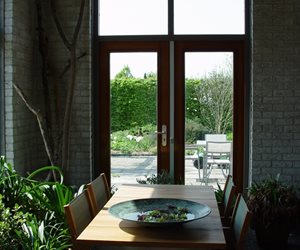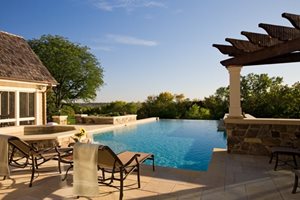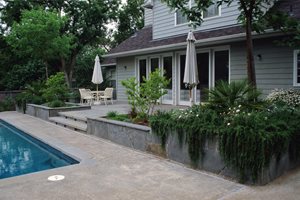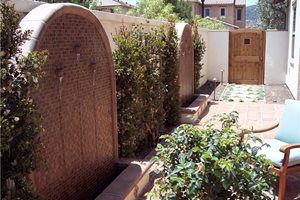5 Most Common Landscape Design Mistakes
How to avoid troublesome errors on your outdoor landscape design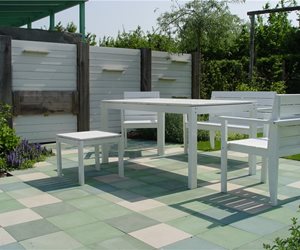
Where space is limited, this designer extended the edge of the too-small patio outward behind each chair location to allow them to slide back safely.
Believe it or not, building a poorly designed landscape can cost just as much as building a well designed one. So when you're forking over big bucks to create the outdoor living space or garden of your dreams, it pays to get the design just right. In fact, the more time you spend on the outdoor landscape design by reviewing its nuances, the more familiar you will be with the outcome. That eliminates unpleasant surprises during the chaos of construction or later on after the crew has left the yard.
Mistake #1 Spaces created are too small to use.
For Patios
This is a typical problem for small urban homes, condos or small country club residences where outdoor space is minimal, but it can happen in larger landscapes too. When making patios, walkways and gates, beware of undersized dimensions. Here's why: A patio that leaves little room to slide your chair back from the table results in a chair leg falling off the deck or slab. Servers can also suffer the same fate creating liability. That is why a 10' by 10' space should be considered bare minimum for a 5' diameter table with chairs. Get more information about properly sizing patios and walks with these backyard patio dimensions.
Minimum Patio Dimensions:
| Patio Seating | Dimensions |
|---|---|
|
5' diameter table with chairs |
Minimum 10' x 10' space |
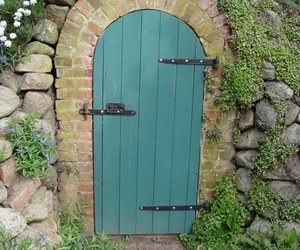
Though charming, this sideyard gate is so narrow it becomes a bottleneck for access with any large item such as a mower.
For Walkways
Functional walkways must be wide enough to accommodate a wheelbarrow, lawn mower or garbage can. Though 3' is standard, some designers narrow it to 30" which becomes problematic. Consider 4' wide an even better choice if possible because this also dictates the dimensions of the gate. Otherwise this bottleneck can cause you to bark your knuckles on the gate posts every time you pass through with a large item.
Mistake #2 Failure to connect indoors with outdoors.
If your outdoor landscape is successfully designed to become a visual extension of adjacent rooms, the whole will seem greater than the sum of its parts. This is doubly important in smaller homes where the patio or garden is vital to utilizing every square inch of what can be very expensive real estate. Beware of a design that fails to do this in every possible way.
This connection relies on carrying the colors, textures and style of your indoor spaces over the threshold to the outdoor materials choices. When the French doors or slider is closed, your eye should travel across the room and through the glass to the outdoors as seamlessly as possible. When the doors are thrown open you want the transition point to literally disappear. Key to this is paving materials that are nearly identical, such as travertine flooring indoors and a matching ceramic tile or imprinted, colored concrete outside. Also key is to match the decorating style to furniture, plants, exterior partitions, and decor outside.
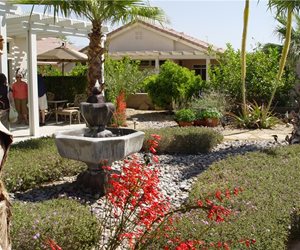
You don't feel a design that's piecemeal because four different types of surfacing and gravel, a combination of traditional garden and desert garden plants with potted herbs thoughtlessly in the center support no overriding style.
Mistake #3 Piecemeal design.
Creating a large or intricate landscape can take time and a lot of money, so many elect to build it one item at a time. The most common example is the swimming pool, a highly valued and often used amenity. The contractor comes in to design the pool within a new home yard exclusively from his or her point of view. These early decisions later become the overriding criteria for the rest of the landscape. It becomes an afterthought, and looks like it too.
When you tell your designer you want "phased installation", he or she will design your entire project up front. This way it is all visually and functionally integrated for maximum beauty and economic efficiency. You can construct any part without conflicts with the rest of the space any time in the future. If the pool goes in first, the design will tell the contractor where mechanical must be located, how safety fence works with adjacent outdoor living spaces, where surfaces should drain without damaging planting and so on. The answers are all there on the plan, so no one is making a decision arbitrarily without taking into consideration all the elements of an holistic landscape.
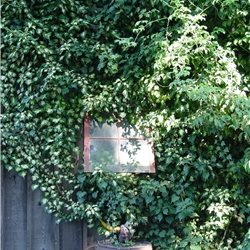
When a plant such as this ivy is used in a small space, it will require future pruning on a regular basis to keep it attractive and in bounds.
Mistake #4 Oversized plants.
Planting design is all about selecting the perfect plant for every space in the landscape. That plant should fit in the space provided when it reaches maturity, which is its maximum height and diameter. This is particularly important with shrubs used in foundation planting around the house. When a plant selected grows too large for the space provided, particularly when it is in a crucial spot such as a tight entry or beneath a window, the gardener must prune it to size. This is most often done by shearing the plant into the space, which spoils its foliage, flowers, and sometimes attractive fruit. When you see homes with a lot of shearing going on, it's because the plants have outgrown their spaces. It also tells you there's a lot of maintenance required to keep it looking good.
A good designer knows the dimensions and character of every plant he or she specifies for a project. This allows the plant to reach its ultimate size while retaining its natural beauty as envisioned on the drawing board. It does not become a box, ball or pyramid. The plant, like its siblings in the wild, grows to be relatively maintenance free, saving you labor, time and money.
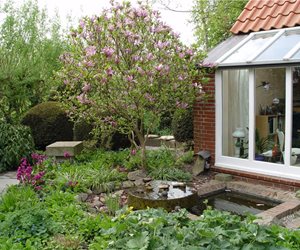
This very small entry yard is so well designed it offers excellent access and beautiful views year around.
Mistake #5 Underestimating importance of good design.
As stated above, a beautiful, well designed landscape costs the same as a poorly designed one. This difference is with the designer. Well trained landscape designers who work with a large palette of plants and materials as well as a wide range of styles are geared to give you a fine project. An installer who has little training may get the plan done, but it won't be great and it will do even less for the beauty and enjoyment of your home.
Plan to spend a bit more time to find a reputable designer. Make calls and ask for references. Talk to former clients to verify all claims. Visit those jobs if you can. For just as an architect can design an ordinary tract house or a beautifully detailed cottage, a landscape designer can create a vital and lovely outdoor living space, or just a patio and some plants for about the same price.

 Backyards
Backyards
 Front Yards
Front Yards
